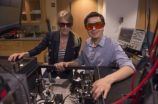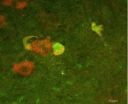(Press-News.org) Scientists have long known that a molecule's behavior depends on its environment. Taking advantage of this phenomenon, a group of researchers at the University of Chicago developed a new technique to map microscopic environments using the vibrations of molecules.
"It's a special new advance that will be broadly useful in studies of molecular and materials phenomena," said Andrei Tokmakoff, the Henry G. Gale Distinguished Service Professor in Chemistry at UChicago. He and two of his associates report their new technique in a paper published online in the journal Optics Express.
The new technique builds on ultrafast two-dimensional infrared spectroscopy, which emerged approximately 15 years ago as a method to probe molecular vibrations. When a laser pulse strikes a molecule, parts of its energy is transferred into the vibrations of the molecule. The ability of each single molecule to get rid of this excess energy, or relax, depends on the neighbors' ability to accept such energy. Thus molecules in different environments will relax at different rates, which are then used to determine the environment of individual molecules. Combining two-dimensional spectroscopy with a microscope enabled the researchers to directly visualize the microscopic variations in chemical environments.
"It's a new, hybrid technique that combines the spatial resolution of microscopy with the molecular information of infrared spectroscopy," said Carlos R. Baiz, a postdoctoral fellow and the article's lead author. The technique offers data on vibrational dynamics that traditional microscopy lacks, while adding spatial information that infrared spectroscopy alone can't provide.
"The new technique lends itself to multiple applications," said Denise Schach, a postdoctoral fellow in chemistry and co-author of the Optics Express article. "We aim to observe the protein folding process, which is the basis of biological function, inside a single cell." In the future, the new technique might especially benefit research in cellular biology and biomedicine.
Mapping vibrational frequencies
Two-dimensional IR spectroscopy can measure molecular dynamics at the femtosecond (quadrillionth of a second) timescale, which is the vibrational frequency of a chemical bond. The method is used to correlate different vibrational frequencies of a molecule, in order to learn about its structure as well as its chemical environment. Combined with microscopy, the method offers a spatial resolution of 20 microns, about the size of a human skin cell.
"Consider a system of coupled springs: you can pluck one spring and see the energy transfer from this one oscillator to all the other springs in the system," Baiz explained. "It's the same effect with molecules. The laser excites one vibration which then relaxes into other nearby vibrations on the same molecule or its neighbors, and where the vibrational energy ends up tells us about the structure and environment of the molecule."
Multiple factors contributed to the success of Tokmakoff's team, which conducted preliminary experiments for two years at MIT, that enabled the group to plot the best way to develop the new method. Once Tokmakoff joined the UChicago faculty in 2013, his startup funds financed the purchase of the sophisticated and expensive equipment that his team needed to implement the plan.
"The facilities are excellent here" said Baiz, referring to Tokmakoff's laboratory space in the Gordon Center for Integrative Science, which is equipped with stringent temperature and humidity controls, the most technologically advanced optical components, and a brand new microscope.
Also important was the purchase of a new pulse shaper that enabled the researchers to modulate individual laser pulses in a way that traditional optics cannot do, and developing a new way of collecting data that involved a different geometric alignment of the laser beams.
INFORMATION:
Citation: "Ultrafast 2D IR Microscopy," by Carlos R. Baiz, Denise Schach, and Andrei Tokmakoff, Optics Express, Vol. 22, Issue 15, pp. 18724-18735, 2014. http://dx.doi.org/10.1364/OE.22.018724.
Watching chemistry in motion: Chemical environments mapped using molecular vibrations
2014-08-05
ELSE PRESS RELEASES FROM THIS DATE:
Physicists eye neural fly data, find formula for Zipf's law
2014-08-05
Physicists have identified a mechanism that may help explain Zipf's law – a unique pattern of behavior found in disparate systems, including complex biological ones. The journal Physical Review Letters is publishing their mathematical models, which demonstrate how Zipf's law naturally arises when a sufficient number of units react to a hidden variable in a system.
"We've discovered a method that produces Zipf's law without fine-tuning and with very few assumptions," says Ilya Nemenman, a biophysicist at Emory University and one of the authors of the research.
The ...
'Treatments waiting to be discovered' inside new database
2014-08-05
Your genes are blueprints for proteins, and molecules called microRNA can help to determine how often these genetic blueprints are manufactured into proteins. Researchers often ask what microRNA regulates a gene related to disease. Or what gene is regulated by a microRNA found in sick patients? The answers to these questions could help doctors and researchers manipulate protein levels in the body that cause disease, especially cancer. A University of Colorado Cancer Center study recently published in the top-ranked journal Nucleic Acids Research (NAR) describes a database ...
Monthly preventative treatment with a new drug combination reduces malaria in children
2014-08-05
Preventative treatment with a monthly dose of a newer antimalarial drug can reduce the risk of malarial infection among young children, according to a study published in this week's PLOS Medicine. The study, conducted by Victor Bigira and colleagues at San Francisco General Hospital and the Makerere University College of Health Sciences in Kampala, Uganda, finds that treating young children with dihydroartemisinin-piperaquine (DP) decreased their risk of contracting malaria.
Preventative treatment of malaria is a useful strategy to protect young children in Africa, but ...
Pregnant women are often given inappropriate treatment for malaria
2014-08-05
Not all pregnant women with symptoms of malaria seek care from their formal healthcare system and if they do seek care, they may be given inappropriate treatment because healthcare providers often fail to adhere to the standard (World Health Organization-WHO) diagnostic and treatment guidelines, according to a study by UK researchers published in this week's PLOS Medicine.
The authors (led by Jenny Hill from the Liverpool School of Tropical Medicine) reached these conclusions by reviewing all relevant studies that investigated the factors that affect pregnant women's ...
A campaign involving Muslim clerics has increased uptake of polio vaccination in Nigeria
2014-08-05
A coalition campaign involving imams, Islamic school teachers, traditional rulers, doctors, journalists, and polio survivors is gradually turning the tide against polio vaccine rejection in northern Nigeria, according to experts from Nigeria writing in this week's PLOS Medicine.
Sani-Gwarzo Nasir (from the Federal Ministry of Health in Nigeria) and colleagues describe how anti-polio propaganda, misconceptions, and violence against vaccinators present huge challenges to polio eradication in Nigeria but perhaps most profound is the rejection of vaccination by Muslim clerics.
However, ...
Just one simple question can identify narcissistic people
2014-08-05
COLUMBUS, Ohio – Scientists have developed and validated a new method to identify which people are narcissistic: just ask them.
In a series of 11 experiments involving more than 2,200 people of all ages, the researchers found they could reliably identify narcissistic people by asking them this exact question (including the note):
To what extent do you agree with this statement: "I am a narcissist." (Note: The word "narcissist" means egotistical, self-focused, and vain.)
Participants rated themselves on a scale of 1 (not very true of me) to 7 (very true of me).
(How ...
Salk scientists uncover new clues to repairing an injured spinal cord
2014-08-05
LA JOLLA—Frogs, dogs, whales, snails can all do it, but humans and primates can't. Regrow nerves after an injury, that is—while many animals have this ability, humans don't. But new research from the Salk Institute suggests that a small molecule may be able to convince damaged nerves to grow and effectively rewire circuits. Such a feat could eventually lead to therapies for the thousands of Americans with severe spinal cord injuries and paralysis.
"This research implies that we might be able to mimic neuronal repair processes that occur naturally in lower animals, which ...
Year-round preventive treatment reduces malaria risk in young children
2014-08-05
A year-round preventive drug treatment substantially reduces young children's risk of contracting malaria and poses no serious risk of adverse events, according to a study by researchers funded by the National Institutes of Health.
The findings demonstrate that prolonged treatment given from 6 to 24 months of age is safe and effective for young children, according to the study authors. Year-round preventive measures are badly needed in locations like Uganda, where the study took place, and where malaria rates remain high throughout the year.
Most previous studies using ...
How spiders spin silk
2014-08-05
Spider silk is an impressive material; lightweight and stretchy yet stronger than steel. But the challenge that spiders face to produce this substance is even more formidable. Silk proteins, called spidroins, must convert from a soluble form to solid fibers at ambient temperatures, with water as a solvent, and at high speed. How do spiders achieve this astounding feat? In new research publishing in the open access journal PLOS Biology on August 5, Anna Rising and Jan Johansson show how the silk formation process is regulated. The work was done at the Swedish University ...
In search for Alzheimer's drug, a major STEP forward
2014-08-05
Researchers at Yale School of Medicine have discovered a new drug compound that may help reverse the cognitive deficits of Alzheimer's disease. Their findings are publishing on August 5 in the open access journal PLOS Biology.
The compound, TC-2153, inhibits the negative effects of a protein called STriatal-Enriched tyrosine Phosphatase (STEP), which is key to regulating learning and memory. These cognitive functions are impaired in Alzheimer's.
"Decreasing STEP levels reversed the effects of Alzheimer's disease in mice," said lead author Paul Lombroso, M.D., professor ...


